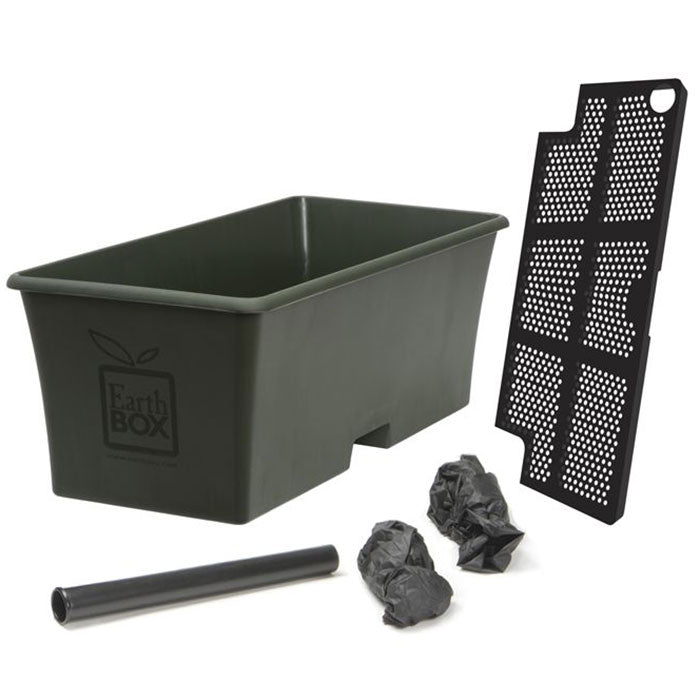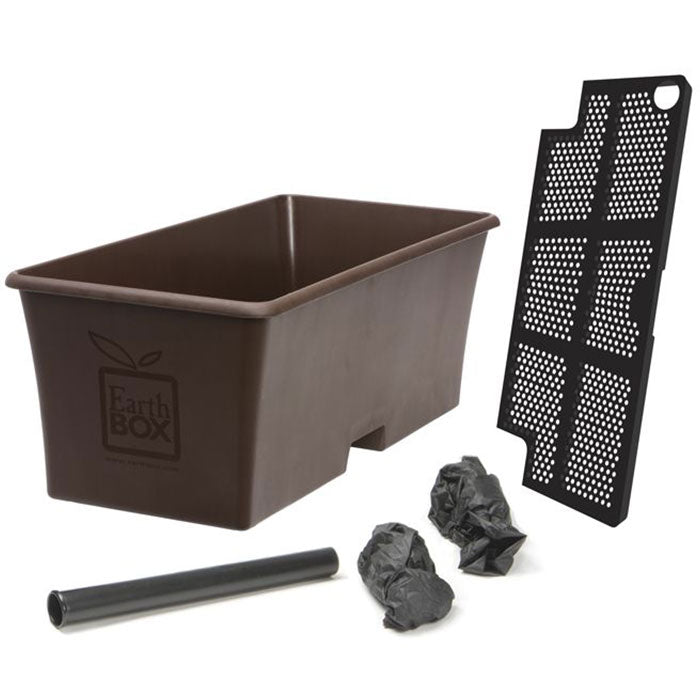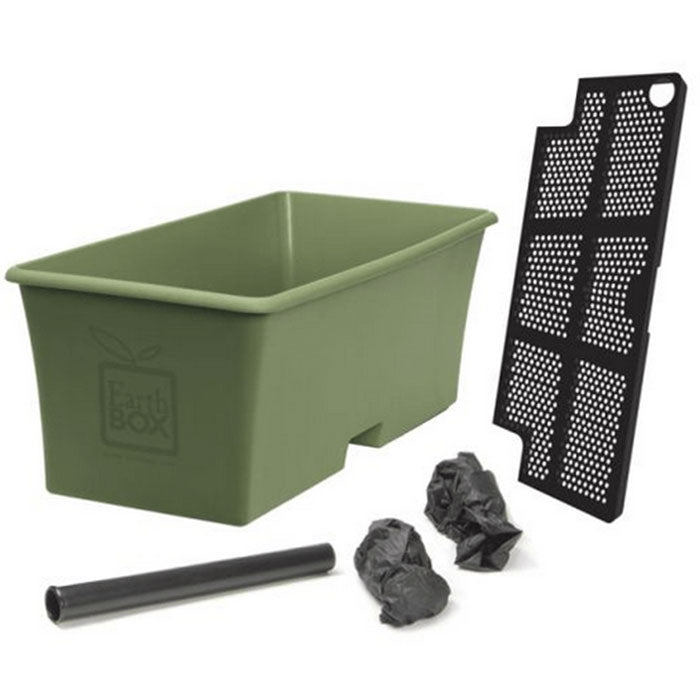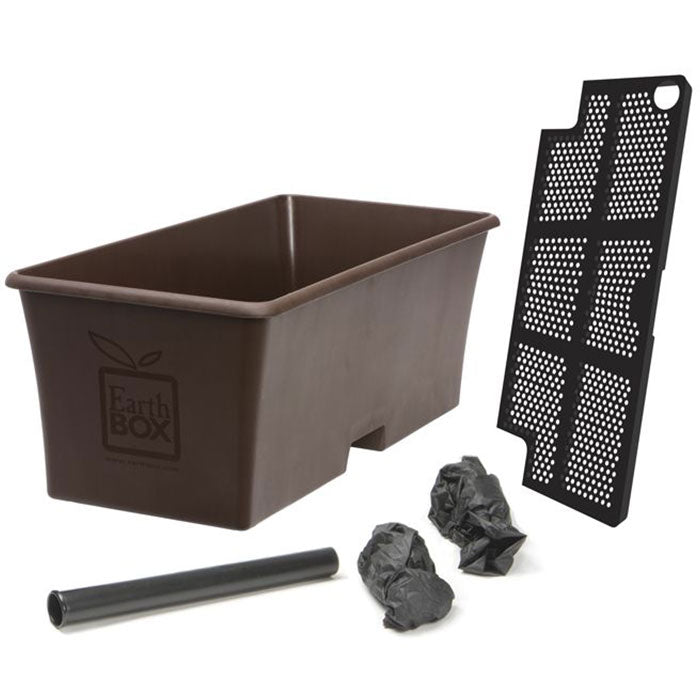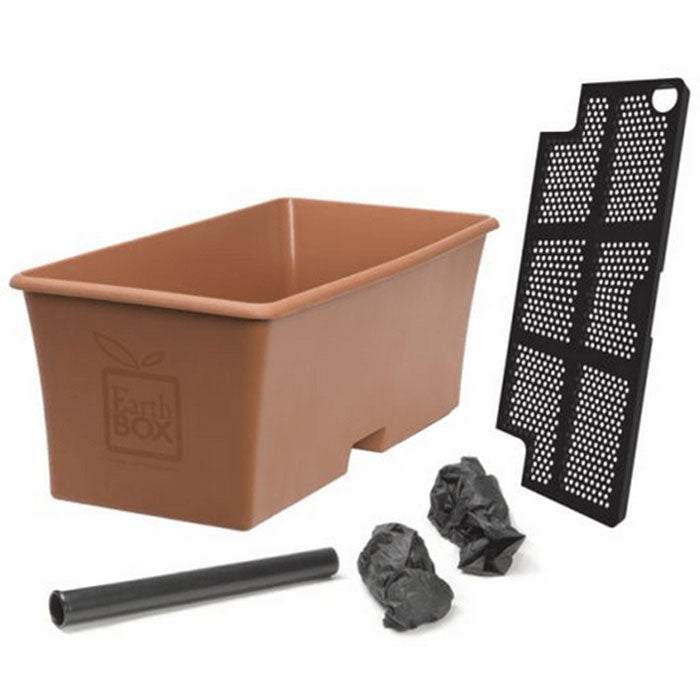EarthBox Sub Irrigated Planter Questions & Answers
Q: What are the dimensions of the EarthBox Original Container?
A: The dimensions of the EarthBox Original are 29" L x 13.5" W x 11" H. It holds 3 gallons of water and 2 cubic feet (60 dry quarts) of growing media.
Q: Are seed or plants included with the gardening system?
A: Seeds are not included with your EarthBox gardening system. When available, we do offer a selection of seed packs, and some Value Bundles may include seeds as a promotional offer when available. We do not sell live plants at this time.
Q: Do I really need to use the Mulch Cover?
A: Yes! The Mulch Cover is what protects the growing environment of the entire EarthBox gardening system. It helps conserve water by limiting evaporation, and it prevents heavy rains from washing away all the plants’ fertilizer and nutrients. The Mulch Cover also protects the growing media from weeds and pests. Place the cover on the system before planting and leave it on until your growing season is over and you’re ready to remove the plants and clean up the growing system.
Always use the Mulch Cover, even in very hot climates. If your local temperatures are typically over 85° F during the peak growing season, place the Mulch Cover on the system with the white side facing up. This will reflect the sun so small plants don’t become stressed from the heat.
For cooler climates where early growing season temperatures may still be too cold for some plants, place the Mulch Cover on the system with the black side facing up. This will attract the sun and warm the growing media to help small plants grow.
Q: How many plants can I grow in the system?
A: The number of plants you can grow per system at one time will vary based on the type of plant. The included Plant Placement Chart indicates how many plants you need and where to place them. For first-time EarthBox gardeners, we don’t recommend growing more than one type of crop per system.
The Plant Placement Chart is the tried-and-true method for the very best EarthBox results. With nearly 30 years of success, our researchers and gardening experts have determined the ideal number and position for each type of crop.
Always follow the recommendations in the instruction manual and on the EarthBox Blog for best results. The age-old adage "less is more" applies to the EarthBox gardening system; by overcrowding the growing system, you risk crop failure due to plants competing with one another for water, fertilizer, and sunlight.
Q: How will I know when to add water?
A: A good rule of thumb is to add water every day to the Fill Tube until water starts to flow from the overflow drain. By filling the water reservoir every day, you are ensuring plants always have what they need.
For the first few weeks after transplanting small seedlings to the system, it may seem like the reservoir is still very full. Roots are still small and developing so they are not taking a lot of water in this phase. Once more leaves develop and the plants begin growing tall and filling out, they will start requiring more.
On very hot days, or if plants are kept in direct sunlight all day, they may require more water because they are heat-stressed. Plants that bear fruit (tomatoes, peppers, squash, etc.) will need more water than herbs and greens. If you are growing fruiting crops, be sure to fill the water reservoir first thing in the morning, and again later in the day or evening. Tomatoes can take up to 10 gallons per day when they are producing fruit, depending on the variety of the plant and the climate they are grown in—which means you may need to add water 2-3 times per day during this phase.
Q: Do I need to use herbicides, pesticides, or other controls when growing in the EarthBox gardening system?
A: You will not need to use any herbicides in the EarthBox system. The mulch cover is designed to keep weeds out so that your plants have all the fertilizer for themselves to grow healthy and strong instead of competing with weeds.
Pesticides and disease control sprays, whether you choose organic or conventional options, may be beneficial to your plants depending on common garden problems and pests in your area. It is your personal choice whether you want to use these controls. If you choose to use any sprays or powders, always follow the application instructions on the product label.
Disease control sprays can be used to help prevent diseases on your plants when they are used before plants have a chance to acquire the disease. Without preventive spraying, plants are susceptible to any number of diseases, which can occur from poor air circulation, infection by the saliva of chewing insects, airborne spores, and more. Once a plant is infected with a disease, there is no cure for it and the spray will aid in slowing the progression only. Always follow the directions on the disease control label.
Pesticides should be used only if you have a known pest in your area that you want to prevent, or if your plants have become infested. Keep in mind that many pesticides—even organic ones—can easily wipe out any beneficial insects on your plants in addition to the bad ones. If you choose to use pesticides or disease control products, never spray or dust when bees and butterflies are active, typically in the mornings and daytime hours. Always wait until dusk when there is no insect activity and plants cannot be burned by chemicals from being in the sun. Always follow the directions on the pesticide label.
It is important to inspect plants daily to check for eggs or larvae, insect damage, frass, discoloration, wilting, and overall plant health. A good time to do this is when you are filling the water reservoir. If you see insects or eggs on your plants and you don’t know what they are, don’t remove or kill them right away. Many beneficial insects will lay eggs, which will help your garden once they hatch; but until they grow into the more easily recognizable adult insects you may be familiar with, you may not know what they look like in other lifecycle stages.
Q: What happened to the standalone Container Garden System, Garden Kit, and Ready-To-Grow Kit?
A: Nothing! We simply combined what used to be 3 separate product pages into 1 where you can decide which components you'd like to buy. You can use the below reference if you're unsure what you purchased from our old site.
EarthBox Container Gardening System - This is our base version and is equivalent to selecting "None" for all the above options since the EarthBox Original Container Gardening System does not come with casters, fertilizer & dolomite, or growing media (i.e. potting soil/mix).
EarthBox Garden Kit - This is our most popular version which includes casters and your choice of standard or organic fertilizer. This is equivalent to selecting "4 Casters", "Standard 7-7-7" or "Natural 8-3-5" fertilizer & dolomite, and no growing media.
EarthBox Ready-To-Grow - As the name implies, this includes everything you need to start growing! This popular version is identical to the Garden Kit but also includes our organic potting mix.
